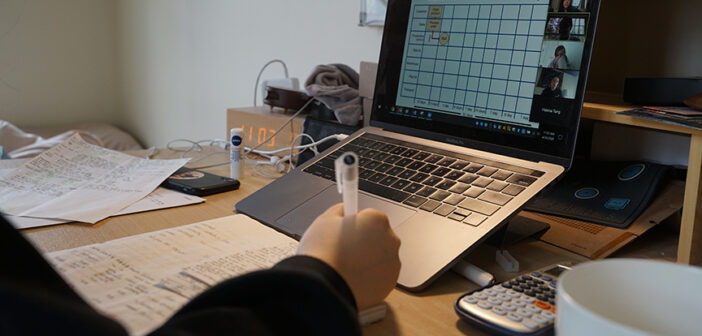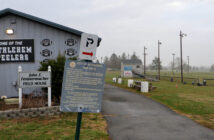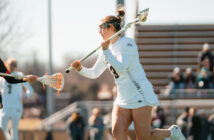In some classrooms, multiple cameras and microphones capture the space, with the lectures ultimately streamed online for isolated students. In other rooms, professors place their laptops at the front with Zoom running, which can be a hit or a miss.
The rise in COVID-19 cases over the past few weeks has prevented some students from attending their classes in person. It has largely been up to individual professors how they choose to accommodate those unable to make class due to a positive COVID-19 test or potential exposure.
The university gave faculty members the option to hold their classes remotely for the week of Sept. 6. From the week of Sept. 13 forward, however, professors have been urged to hold class in person, with the option to shift online if over 30 percent of students are unable to attend.
Augustine Ripa, a theater studies professor, teaches two courses in Zoellner Arts Center. They are held in the diamond and black box theaters.
During the week of Sept. 6, Ripa held both of his classes virtually as he had a number of absences and wanted to avoid creating two different experiences—one for students able to attend and one for those unable to.
Ripa said it is not possible to have the same learning experience online, but he does see certain advantages of Zoom, such as being able to see his students’ faces without masks.
“I can’t see people’s lips. I can hardly hear them sometimes if they’re sitting far away, and I’m teaching a performance class in the black box theater. I can’t see the subtle facial nuances,” Ripa said. “It kind of redefines what performance means. One of the bizarre advantages about Zoom is I can see your face.”
Ripa said when he requested the two theaters as classrooms for the semester, he did not foresee the possibility of a return to hybrid or online instruction. The spaces his classes utilize are not typical Lehigh classrooms, and although he believes proper hybrid learning infrastructure could enhance his teaching experience, he does not view it as the highest priority at the moment.
Provost Nathan Urban said LTS sent out an email to all faculty saying they have portable systems of various kinds to allow for video and audio recordings in classrooms. So, a professor can have their hybrid learning resources amplified upon request.
Greg Reihman, vice provost for LTS, said there are roughly 150 classrooms available to be scheduled for use this semester by the registrar. Of them, just over one-third have videoconferencing capability.
He said LTS, anticipating a need for greater flexibility for students, added additional technology in classrooms this past summer and purchased additional devices that can be installed temporarily or signed out by instructors
“We have a list of best practices, but the real life experience of faculty members who are trying to accomplish that sometimes hits all the right notes and sometimes doesn’t,” Reihman said. “We know not every classroom has the high end video conferencing technology. Because each course requires different uses of pedagogy, we’ve presented faculty with a range of options. We don’t know what every faculty member has chosen to do but we’re there if they need help.”
Reihman said there are some limitations on what faculty are able to do for students. He said despite technological aids, there are certain aspects of the in-person experience that cannot be replicated through hybrid learning.
Jason Travers, a professor of art, architecture and design, said prior to COVID-19, he had no experience using Zoom, Panopto or GroupMe. He said this time around, he and his colleagues are better prepared.
Many of them have set up WordPress blogs they can quickly transition to if necessary. Travers said it also helps to have had the foundation of a few weeks of class to get to know students in person.
Travers has found that certain activities translate to an online format better than others. He said in design classes, he has been able to make software tutorials for students and has a bank of these to aid in teaching.
With regards to providing hybrid solutions, Travers said he finds it challenging to create an adequate Zoom experience for an individual student, but his department has received a lot of support from the university. He was able to seek help when faced with vocal issues and received a stand to put his phone on for Zoom and a microphone to better communicate with students.
Although Travers acknowledged students and faculty are better prepared for a move to hybrid or entirely online learning than they once were, he believes the mental toll of a return would be high.
“I think it would be psychologically devastating for all of us,” Travers said. “One of the things that was unexpected at the beginning of this semester was the positive emotion and optimism of everyone being together. Students coming in with this new vitality made us realize there is no substitute for in-person teaching, especially with the hands on things we do.”
Don Morris, professor of earth and environmental science, was surprised the university wasn’t ready for the influx of cases after having dealt with COVID-19 for the previous 18 months.
Morris said he is not teaching any classes with a lab component this semester so he does not see a major issue if his classes had to shift entirely online.
He said the EES department was well-prepared for the rise in COVID-19 cases this semester. Last year, many faculty taught in a hybrid format, offering sections that were partially in person and online.
The STEPS building, which is roughly a decade old, houses the EES department and is one of the newest buildings on Lehigh’s campus. STEPS classrooms have features such as cameras and microphones installed.
Like Travers, Morris finds there are certain elements of teaching and learning that can be done well in an online format, however, he believes students taking lab courses virtually will not get the same educational opportunities that come with physically handling materials and collaborating with peers.
“It’s the feelings of the faculty and the staff that we want to interact with students and do it in an in-person way but COVID-19 is going to have the last word,” Morris said. “Public health is going to rule so we have to try and make do.”
Morris said more classrooms need to offer video conferencing technology to provide a seamless solution for hybrid-teaching.
Alondra Perez, ‘23, an environmental studies major, said her professors have accommodated students in different ways. According to her, some have supported students more than others.
She said some of the hardships faced by students in isolation are difficulty hearing and feeling like a part of the class. Specifically, in classrooms that are not equipped with video conferencing technology, Perez said students have trouble seeing and hearing the lessons being taught.
Perez said in classes without proper hybrid learning infrastructure, professors often set their laptops up in the front of the room with Zoom on.
“I’m not trying to act like professors are the bad guys, it can be very difficult for them as well,” Perez said. “But after a year and a half of being virtual, we should have been better prepared for this.”






Comment policy
Comments posted to The Brown and White website are reviewed by a moderator before being approved. Incendiary speech or harassing language, including comments targeted at individuals, may be deemed unacceptable and not published. Spam and other soliciting will also be declined.
The Brown and White also reserves the right to not publish entirely anonymous comments.